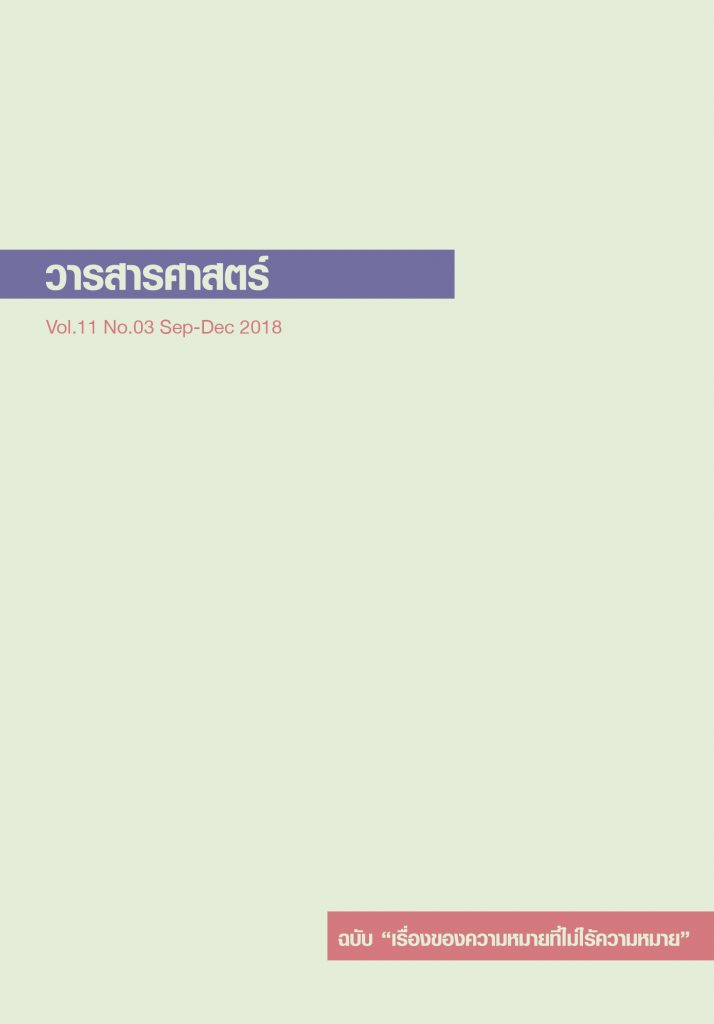Representation of Mahajanaka
คำสำคัญ:
Mahajanaka, His Majesty King Bhumibol Adulyadej, Dhamma Raja, the Righteous King, Dasarajadhamma, Ten Principles of a Righteous Kingบทคัดย่อ
การศึกษาเรื่องภาพตัวแทนของพระมหาชนก มีวัตถุประสงค์เพื่อศึกษาความเป็นภาพตัวแทนของพระมหาชนกในบทพระราชนิพนธ์ พระมหาชนก กับผู้ประพันธ์คือพระบาทสมเด็จพระปรมินทรมหาภูมิพลอดุลยเดช ด้วยเห็นว่าพระราชนิพนธ์องค์นี้ แม้เป็นองค์ที่สามรองจาก นายอินทร์ผู้ปิดทองหลังพระ (2537) และ ติโต (2538) แต่เป็นองค์ที่พระบาทสมเด็จพระปรมินทรมหา-ภูมิพลอดุลยเดชทรงโปรดมากที่สุด และถูกตีพิมพ์เผยแพร่ในวโรกาสฉลองสิริราชสมบัติ ครบ 50 ปี เมื่อ พ.ศ. 2539 จึงทำให้มิอาจปฏิเสธการเชื่อมโยงการสื่อ ความหมายของความเป็นราชาระหว่างพระมหาชนกและพระบาทสมเด็จ- พระปรมินทรมหาภูมิพลอดุลยเดชได้
การศึกษาใช้แนวคิดการถอดความตัวบทของกาดาเมอร์ที่ว่า ภาษามีบทบาทในการสื่อความหมายระหว่างผู้ส่งสารและผู้รับสาร สารที่ถูกสื่อออกไปมักไม่ตรงกับสารที่ผู้รับสารถอดความออกมา เนื่องจากข้อจำกัดของประสบการณ์การสื่อความ ความเข้าใจภาษา หรือประเภทสื่อที่แตกต่างกัน รวมถึงมิติการคาดคะเนความหมายในถ้อยความที่ถูก “กล่าวถึง” ไปสู่ความหมายที่ “มิได้ถูกล่าวถึง” และผู้วิจัยเลือกแนวคิดการเป็นภาพตัวแทนในมุมมองที่ผู้รับสารถอดความหมายจากตัวบทของไดเยอร์และสร้างความหมายบนฐานความเป็นจริงของตนของฮอลล์
การศึกษาพบว่า พระมหาชนกในบทพระราชนิพนธ์ พระมหาชนก เป็นภาพ ตัวแทนของพระบาทสมเด็จพระปรมินทรมหาภูมิพลอดุลยเดช 3 ประการ คือ ความเป็นราชา บุญญาธิการ และธรรมราชา ความเป็นราชาของพระมหาชนกจาก การสืบสายโลหิตสะท้อนความเป็นราชาของพระบาทสมเด็จพระปรมินทรมหาภูมิพลอดุลยเดชที่มีภูมิหลังคล้ายคลึงกันในเรื่องชาติกำเนิด ประสบการณ์ การขัดเกลาทางสังคมครั้งเยาว์วัย แม้ว่าจะแตกต่างกันในรายละเอียดการขึ้น ครองราชย์ การเป็นผู้มีบุญญาธิการเป็นความเชื่อตามวัฒนธรรมไทยที่สะท้อนจาก พระราชพิธีต่างๆ และความเป็นธรรมราชานั้น สะท้อนจากที่กษัตริย์ทั้งสอง พระองค์ทรงบำเพ็ญทศพิธราชธรรม โดยเฉพาะวิริยะบารมีร่วมกับการใช้ความเป็นเจ้าชีวิตและเจ้าแผ่นดินเพื่อพัฒนาคุณภาพชีวิตของพสกนิกรรวมถึงการ ก่อตั้งสถาบันการศึกษาหรือศูนย์การเรียนรู้ด้านการเกษตรและการพึ่งพาตนเอง ยิ่งไปกว่านั้น พระบาทสมเด็จพระปรมินทรมหาภูมิพลอดุลยเดชทรงรักษา พระราชสัญญาในปฐมบรมราชโองการเมื่อวันที่ 5 พฤษภาคม พ.ศ. 2493 ว่า “เราจะครองแผ่นดินโดยธรรมเพื่อประโยชน์สุขแห่งมหาชนชาวสยาม”
References
Bhumibol Adulyadej (1996), The Story of Mahajanaka, Bangkok: Amarin Printing and Publishing PCL.
Chanchaochai, D. (2006), King Bhumibol Adulyadej of Thailand: By the Light of Your Wisdom Vol. 3., Bangkok: DMG Books.
Charoenpongs, S. (2006), “Dhammaraja : Phra Phu Song Metta Tor Sappa Chewit”, in Tai Rom Phra Barami Phra Borommikaraja gub Aksornsart, Bangkok: Faculty of Arts, Chulalongkorn University.
Chongstitvatana, S. (1999), “Mahajanaka : Mohkkatam Hang Pudjubansmai”, Journal of Thai Language and Literature, 16: 185-201.
Chuensuksawadi, P. (1996), King Bhumibol Adulyadej: Thailand’s Guiding Light, Bangkok: The Post Publishing.
Grondin, J. (1995), Sources of Hermeneutics, New York State: University of New York Press.
Grossman, M. (2012), King Bhumibol Adulyadej: A Life’s Work, Thailand: Editions Didier Millet.
Jamornmarn, S. (2007), King Bhumibol Adulyadej: The Great King of Communication, Thailand: Foreign Office,Public Relations Department, Officeof the Prime Minister.
Jones, R. (2000), King Bhumibol: Strength of the Land, Thailand: National Identity Office,Secretariat of the Prime Minister, Office of the Prime Minister.
Jumbala, P. (1992), Nation-Building and Democratization in Thailand: A Political History, Bangkok: Chulalongkorn University Social Research Institute.
Kosaiyakanont, S. (n.d.), “Language and Culture in Mahajanaka Story written by King Bhumibhol”, Cultural Heritage Newsletter, Rajamangala University of Technology Phara Nakorn, 9 (14): 8-12.
National Economic and Social Development Board (1999), The Monarch Who Is the Strength of the Land, Bangkok: United Production Press.
Nilkumhang, S. (1986), King Ananda Mahidol, Bangkok: Fine Arts Department and Atthamarajanusorn Foundation.
Puengprasert, S. (2000), Thai Monarchy, Bangkok: Foreign Officeand the Public Relations Department, Office of the Prime Minister.
Sothanasathien, S. (2010), The Discourse of Mahajanaka, Bangkok: H.N. Group.
Sridee, S. (2007), “ReflectedCommunication on Value of pure perseverance education and education institute for the people”, in The Perspectives on the Story of Mahajanaka, Bangkok: n.p.
Webb, J. (2009), Understanding Representation, Bangkok: Sage Publication.
Wongchestha, N. (2007), “Mahajanaka: the Dhamma Raja”, in The Perspectives on the Story of Mahajanaka, Bangkok: n.p.
Online
A Glossary of Pali and Buddhist Terms (2013), retrieved 3 May 2016 from https://www.accesstoinsight.org/glossary.html
Bhumibol Adulyadej (2005), His Majesty’s speech, December 4, 2005, retrieved 3 May 2016 from https://kanchanapisek.or.th /speeches/2005/1204.th.html
Cowell, E. and Rouse, W. (n.d.), Mahajanaka-Jataka. No.539, The Completing Tipitaka: Jataka, retrieved 3 May 2016 from https://tipitaka.wikia.com/wiki/Mahajanaka-Jataka.html
Mahajanaka (1999), Vithayajarn, 98 volume 1, retrieved 3 May 2016 from https://www.moe.go.th/ main2/article/p-maha.html
Officeof Royal Development Projects Board (n.d.), Total of Royal Development Projects, retrieved 10 February 2018 from https://www.rdpb.go.th/
Panyarachun, A. (1998), 1999 Thai Economy: Direction of Thai Industrial Restoration, retrieved 3 May 2016 from https://www.anandp.in.th/th_speech/t050103.html
The Chaipattana Foundation (n.d.), Agricultural Development, retrieved 10 Febrary 2017 from https://www.chaipat.or.th/chaipat_english/index.php?option=com_content&view=article&id=4121&Itemid=296&lang=th.html
Tongdee, S. (1997), Projects Undertaken Through the Initiative of His Majesty the King, Bhumibol Adulyadej of Thailand, retrieved 10 February 2017 from https://u-toseen.com/king9/index.html







